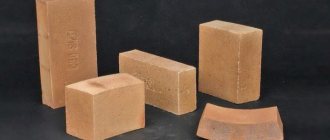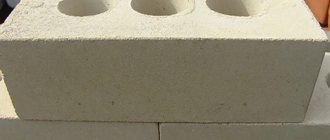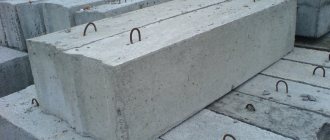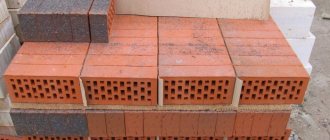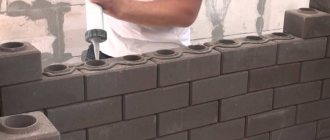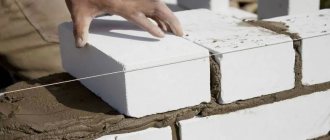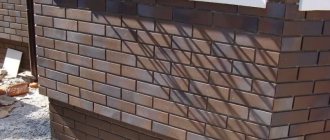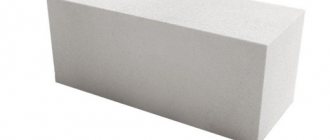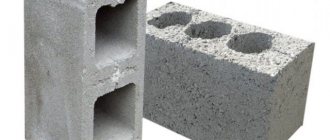When building a furnace, it is important to ensure such parameters as long service life, high heat transfer rates, and optimal furnace dimensions. To achieve them, it is recommended to use special oven bricks. When choosing it, it is important to consider not only the size, but also the physical properties. When the blocks have the correct shape, size, do not have any deviations in appearance, and also provide good traction, then be sure that the constructed stove will serve you well and for a long time.
Dimensions and weight according to GOST
Standard sizes of single, one-and-a-half and double products:
When designing buildings and structures, all characteristics are taken into account, including overall dimensions and weight of red brick.
Manufacturing products according to uniform dimensions allows the designer to easily select elements of a certain format for construction or cladding, and knowing their approximate weight allows them to correctly calculate the load of the structure being built on the foundation.
It will be possible to purchase the material from any manufacturer and at any time after the project has been prepared.
Standard sizes of red brick in normal (regular) 1NF format:
- length – 250 mm;
- width – 120 mm;
- height – 65 mm.
It is the dimensions of single elements, provided for by GOST, that are a kind of reference point - i.e. a material with other parameters will have a different marking instead of 1NF, where the number indicates its proportions to the single one.
So, the size of a one-and-a-half red brick will already be 250 × 120 × 88 mm, and will be designated as 1.4 NF. Products of these formats are produced both as regular and facing ones.
The list of sizes of facing red bricks can be supplemented with euro format products (0.7NF, 250×85×65 mm), and ordinary ones with double elements (2.1NF, 250×120×138 mm).
Dimensions of red brick in Euro format
Thin facing material (euro) will help reduce financial costs for cladding, and large stone (double) will significantly speed up the process of building a house.
Many people are often interested in the question of how thick red brick is. For materials of basic formats (single, one and a half and double) it is standard - 120 mm.
The exception is euro-sized elements, the width of which is reduced to 85 mm.
Deviations from standard sizes
According to GOST, the maximum permissible deviations from standard dimensions on one element (regardless of the format) are:
- length ±4 mm;
- width ±3;
- thickness ±2 mm for front and ±3 for regular material.
Red brick weight according to standard
GOST does not reflect information about how much a single or red brick of other dimensions weighs - the standard only indicates classes of material based on average specific gravity.
Depending on the average density class, products are divided into several groups according to thermal characteristics:
- 2.0 and 2.4 – ineffective (regular);
- 1.4 – conditionally effective;
- 1.2 – effective; 1.0 – increased efficiency;
- 0.7 and 0.8 – high efficiency.
Before moving directly to the question of how much 1 standard red brick weighs, you need to consider its types depending on the structure.
The material is available in several options:
Hollow (slotted)
With voids up to 45%. It is much lighter than the full-bodied one, but less durable.
Solid - the number of voids is no more than 13% of the total volume of red brick. It is distinguished by greater mass, but the strength characteristics of the elements are an order of magnitude higher.
Table 1. Weight (mass) of red brick single (250×120×65 mm), one-and-a-half (250×120×88 mm), double (250×120×138 mm) and euro (250×85×65 mm) formats:
The weight of red facing brick does not differ from the weight of ordinary hollow brick. The only thing worth noting is that products for cladding are produced only in 0.7NF, 1NF and 1.4NF, and there are no double formats for finishing work.
How much does a red stove brick weigh?
Kiln brick
Being interested in the weight of red stove brick, many consumers do not know its main purpose - it is a brick with increased characteristics, but not fireproof.
Note! The material made from ordinary clay is intended for laying the body of the stove and chimney. If you need elements for laying out the internal heated surfaces of the firebox, then special refractory products made from special types of clay are used for this.
If you need elements for laying out the internal heated surfaces of the firebox, then special refractory products made from special types of clay are used for this.
Standard stove material also has fairly high resistance to high temperatures and increased density compared to traditional building or cladding products.
In this regard, to the question of how much a red brick for a stove weighs, we can unequivocally answer that it is heavier than a regular solid brick and its weight is in the range of 3.7-4.2 kg.
Material selection
To make the stove efficient and durable, when choosing ceramic building products you need to pay attention not only to their weight, but also to the following properties:
- Almost perfect surface evenness. If defects, marks, and traces of impurities are visible on individual copies, then the quality of the entire batch is called into question.
- Same uniform red tint.
- Correct form . All edges must be straight, without bends, chips or gouges, and also of the same length so that the masonry turns out without flaws.
- The same mass of all stones.
vote
Article rating
Properties and characteristics
It is more profitable to decorate walls with white sand-lime brick, as opposed to ceramic, because in addition to its physical properties, it is also an excellent finishing material that does not require the additional use of foreign materials for the outside of the building.
White
Sand-lime brick is an artificial building material that contains a number of synthetic substances that increase its strength.
Also, in recent years, bricks of different textures of all colors have become popular, giving the structure a special zest.
Various colors
But before any construction, you must take into account the various parameters of a given brick, its volume, size and weight. All this is taken into account at the stage of creating the project in order to accurately calculate the necessary proportions for the base of the building, the foundation.
Like any building material, sand-lime brick has its advantages and disadvantages. It is not used in the construction of basements or ground floors. The reason for this is high moisture absorption, which reduces the strength of the building if the material was used during construction in places with high humidity.
But there are undoubtedly more advantages of this material:
- environmental friendliness of the material. When creating bricks, only natural components were used, so any building made from this material will not harm the environment in any way;
- the strength of the material is maintained even in areas with increased seismic hazard;
- isolation of external sound. For this reason, the external part of the building is often finished with silicate;
- wide scope of application in construction work. Thanks to different shapes and colors, silicate can be used for cladding building facades;
- high frost resistance.
The weight of sand-lime brick depends on its shape and density.
The standard form of silicate according to GOST is considered:
- length – 250 mm;
- width – 120 mm;
- height – 65 mm.
The weight of silicate brick 250x120x65 is about 4 kg.
The brick mass depends on several factors:
- size;
- forms;
- presence or absence of cavities;
- components in the composition when mixing the silicate mass.
Therefore, when planning to use silicate during construction, you should calculate in advance how many bricks will be needed for masonry.
What is fire brick made of?
The workshop for the production of these products must be equipped with specialized equipment, which is used to prepare raw materials and form finished products. In this case, for the manufacture of heat-resistant brick products the following is used:
- refractory clay – not less than 70%;
- powdered coke;
- graphite;
- quartz powder.
Comparison table for fireproof materials [ads-mob-1][ads-pc-1]
Lay fireclay bricks
The characteristics of the finished product will depend on the additives that the manufacturer uses to make the material.
How many bricks are there in 1m3?
Determining how much red brick is in 1 cube is required when calculating the amount of material for the construction of a building or structure.
There are several calculation methods - with and without mortar joints.
The first method is relevant if it is necessary to calculate the number of products for masonry, and the second - when ordering products, since some manufacturers in the transport characteristics reflect the volume of material (in m3) in 1 pallet.
To calculate how many pieces of red brick are in a cube, you need to calculate the volume of one product (using the example of a single format):
0.25 × 0.12 × 0.065 = 0.00195 m3.
Then you need to divide the original volume (1 cubic meter in our case) by the resulting value:
1/0.00195 = 512 pieces.
Now let’s calculate how much single red brick is in 1 m3 of masonry (i.e., taking into account the seams) - to do this, you need to add the estimated seam thickness to the standard dimensions (length and height) (for example, add 15 mm) and calculate the volume of 1 element:
0.265 × 0.12 × 0.08 = 0.00254 m3 1/0.00254 = 394 pieces.
For example, if the weight of 1 single product is 3 kg, and there are 512 pieces in a cube, then the mass of the entire volume of material will be 1536 kg.
Table 2. Amount of masonry material in a cube:
Solid red ceramic brick Smooth ZSM Etalon M250 250*120*65mm 288pcs
Designed for laying stoves and the outer part of chimneys and furnaces (except fireboxes), for the construction of external (with subsequent plastering or insulation) and internal load-bearing walls. Solid brick has the required thermal conductivity, is able to retain heat and is resistant to thermal shocks.
Specifications:
Ceramic facing brick
Quantity on pallet:
Designed for laying stoves and the outer part of chimneys and furnaces (except fireboxes), for the construction of external (with subsequent plastering or insulation) and internal load-bearing walls. Solid brick has the required thermal conductivity, is able to retain heat and is resistant to thermal shocks.
Technology of creation. The history of the enterprise began in 1877, when, by order of the Construction Department of the St. Petersburg Provincial Board, the first stage of the brick factory was built. Five years later, in 1882, the second stage of the enterprise was put into operation. More than 130 years have passed since then. In 1998, the plant received the name “Etalon Construction Materials Plant” and became part of the Group. From that moment on, production was reconstructed, equipment was updated, and technology was improved. Today it is a sustainable, profitable enterprise. The plant's products are widely used not only by the Etalon Group of Companies, but by a significant part of construction companies in the North-West region. Currently, the company produces facing and ordinary ceramic bricks of various textures and colors.
All factory-produced bricks from ZSM ETALON have a quality certificate. When purchasing such material, you can be sure that the declared parameters are met and the product meets the requirements of GOST.
Capacity of pallets in the machine: Scow 20 t - 16 pallets Manipulator 10 t - 6 pallets Manipulator 10 t - 6 pallets Manipulator 3.8 t - 3 pallets Valdai 3.8 t - 3 pallets In 1 cubic meter. — 512 pcs per 1 sq.m. — 51 pcs.
When purchasing building materials from BLOKspb, you receive: - free calculation of the required amount of material from professionals; — the fastest delivery with unloading; — favorable prices; — all related materials are always available - glue, masonry tools, etc.; — the opportunity to visit our showroom and evaluate the quality of products; — the ability to select and order everything for construction in one place.
You can leave your question
Use this form only to inquire about the product. Fields with * are required.
Types and characteristics of ceramic bricks
The variety of brick products allows them to be separated and classified.
Types of bricks
Artificially produced stone, with given shapes, sizes, weight and composition, can be divided into brick:
In common parlance, they are often divided into red (ceramic) and white (silicate). The difference is mainly in the raw materials used in their manufacture. For red it is clay, for white it is a silicate mixture (sand and lime).
Ceramic products, in turn, are divided into the following types according to their purpose and application:
- Private. It is used in the masonry of load-bearing, enclosing walls and partitions.
- Facial. Used for cladding.
- Special. It is used in the masonry of stoves, fireplaces, chimneys (furnace, fire-resistant fireclay brick).
Standard sizes, their designations
According to the above regulatory and construction documentation, all types of this building material in Russia are standardized in their standard sizes.
Designation by size
Since 1927, standardization of brick products has been carried out. There is a normal format (NF), its geometric dimensions are 250x120x65 (mm).
The name of other standard sizes comes from the normal format:
- 250x120x65 - single (NF);
- 250x120x88 - one and a half (1.4 NF);
- 250x120x140 - double (2.1 NF).
In current documents they are divided and classified according to other sizes:
- 250x85x65 - “euro” (0.7 NF);
- 288x138x65 - modular single (1.3 NF).
Based on the absence or presence of voids in the body, solid and hollow brick products are divided. Based on voidness, the following varieties are distinguished:
The mass of the product, the weight of the masonry, the costs of its construction, and most importantly, the heat-insulating characteristics of the wall depend on the number of voids (the percentage of voids in the total volume).
Scheme: Two-layer wall (solid front and hollow “warm ceramics”)
Weight characteristics
Photo: the weight of a single ceramic brick depends on the volume of voids in it
The mass must be taken into account by designers to calculate the load of masonry on the foundation, to determine the carrying capacity of transport, warehouse equipment (forklift, crane) during logistics operations with it.
It is useful for an estimator, foreman or mason who works with it with his own hands to know that, for example, 1 m3 of masonry made from a single solid brick (about 500 pieces) is approximately 1690 - 1847 (kg). A cube of brickwork made from one and a half bricks - about 380 pieces, and from a double brick - approximately 200 - 240 pieces.
Attention! When making calculations, you can focus on the following figures: in a masonry 1 meter high, about 7 rows of double, 10 rows of one and a half and 13 rows of single bricks fit. We present the main weight values for standard sizes (in accordance with current documents on building materials)
We present the main weight values for standard sizes (in accordance with current documents on building materials).
Designation according to GOST
Hollow double sand-lime brick m 150, dimensions 250x120x138, weighs 5.4 - 5.8 (kg), and hollow double ceramic brick m 150, 250x120x140, weighs 4.3 - 5.0 (kg).
The mass of a solid one 250x120x65 is 3.3 - 3.6 (kg), and a porous one of the same volume is 2.4 kg.
Thus, we see that a large volume (size) does not necessarily mean that its mass will be large. Its weight characteristics are more influenced by its structure.
When choosing the type of building material for walls, it is necessary to take into account their thermophysical characteristics, structure, weight and geometric parameters, what is the price of their acquisition, delivery and further operation.
When laying a large mass of walls, it is advisable to pay attention to one-and-a-half and double bricks, and large-format blocks of “warm ceramics”. To simplify approximate calculations, you can focus on average weight indicators
Solid with voids less than 13% - about 4 kg, hollow with voids more than 15% - approximately 2.5 kg
To simplify approximate calculations, you can focus on average weight indicators. Solid with a voidness of less than 13% - about 4 kg, hollow with a voidness of more than 15% - approximately 2.5 kg.
Main types of bricks
Today, there are two main types of brick blocks that can be used for laying a stove:
- ceramic;
- fireplace
Ceramic bricks, which are made using red clay, can only be produced by firing. If we talk about the advantages of this type of material, then this is, of course, full compliance with GOST standards. This type of brick is usually used to build the upper part of the chimney - where the heat of the stove will not be so strong.
Fireplace bricks can be divided into four types: quartz (made from sandstone and quartz chips with a slight addition of clay), basic (made from a lime and magnesium mixture), carbon (produced by pressing coke and graphite chips) and refractory fireclay (the main material for making clay). For the manufacture of stoves or fireplaces, only quartz and fireclay are used.
If we compare ceramic and fireclay brick blocks, then most often stove makers prefer the fireclay type.
Weight of 1 m3 of brickwork
The quality of brickwork depends on the type of building material and the correctness of its installation
To determine the number of bricks per cube of masonry, it is necessary to take into account the volume of the entire structure. In addition, material consumption is determined by the typical characteristics of the brick and the thickness of the seams
The raw materials used in manufacturing and the processing conditions determine the dimensions (see Standard size of red brick) and the specific weight of the brick (see Weight of sand-lime brick). Regarding brickwork, this parameter also depends on the number of seams, the weight of the mortar used and the type of masonry. Thus, the specific gravity of brickwork is in the range of 1400-1990 kg/m3. The next value required for calculation is volumetric weight (unlike the previous one, the presence of voids and pores is taken into account).
The mass of the masonry wall must be calculated to determine the optimal and limiting loads on the foundation. This value determines not only the type of foundation being built and its material, but also many other design and design parameters.
Today, brickwork remains the most common type of wall. It is characterized by stability and strength, at the same time, it has a decent mass, which affects the foundation of the building.
The most popular material in this case is red brick, the standard dimensions of which in millimeters are 250x120x65, weight - about 4 kilograms. An approximate count occurs because each brick has structural voids that are allowed by the standards, but their number is not constant. That is why for calculations it is more expedient to take the weight of 1 m3 of brickwork, rather than one brick.
When designing any structure, it is necessary to take into account many nuances. In order to fully get a picture of the upcoming loads on the building, plan the foundation and adjust the dimensions of the building, you need to familiarize yourself with the technical characteristics of the material - brick.
Using these parameters, it is possible to give an objective assessment of the load-bearing capacity and strength of a future building, so they must be taken into account when designing.
Quite often, the decent weight of a brick wall prevents the use of this material. This is not possible if the foundation of the building is unstable, wet or moving. In such cases, alternative materials are used that have an advantage over traditional red brick in weight:
- expanded clay concrete blocks;
- foam concrete;
- gas sulphate;
- cinder blocks.
Indeed, all of the above materials make it possible to erect quite practical and lightweight buildings in less time and with some savings. However, they are significantly inferior in strength to classic bricks, and some of them shrink during use.
Do not forget that the weight of a masonry cube can be affected by the reinforcement of walls or individual components of supporting structures. Sometimes the mass of the mortar and reinforcing mesh is not inferior to the weight of the entire wall (see Cement consumption for bricklaying)
Using red brick to create ovens
Creating a furnace requires the following steps:
- Furnace type definitions.
- Development of a building diagram.
- Selection of material for construction, calculation of its quantity, purchase.
- Cost calculation.
- Choosing the location of the furnace.
- Construction of the furnace.
The type of furnace depends on the building in which it will be located. This can be a stove in the country, in a bathhouse, at home or on the street. The masonry technique and appearance of such stoves will certainly differ.
- If you need to build a stove in a house, it is advisable to do this at the stage of its construction. Otherwise, some reconstruction of the house will definitely be required to create a foundation and a chimney for the stove.
- If you need to implement a stove in a bathhouse, you can build a simpler stove-stove design.
Necessary equipment and raw materials
To build a furnace you will need tools, physical strength (people) and materials.
List of construction tools:
- Shovel
- Bulgarian
- Hammer
- Hammer-pick
- Trowel for laying mortar
- Jointing designed to compact mortar
- Metal sieve with a cell diameter of no more than 2 mm
- Five meter tape measure
- Plumb to check vertical angles
- Stove ruler
- Opening template
- Flexible level
- Building level
- Mops
- A large number of rags
- Buckets.
Required material for laying the stove:
- Brick (it is better to use ceramic)
- Water
- Clay
- Sand.
Read about the solution for stove ceramic red refractory bricks below.
Masonry mixture
Before preparing the mortar mixture for laying a brick oven, the clay is soaked for a long time (3-5 hours). After this, it is wiped with a sieve. The clay should not contain lumps, since when laying, the seam should not be more than 5 mm.
The mixture (solution) is obtained by mixing sand, water and clay. Sand and clay can be of different quality and mix differently with each other. Therefore, before starting work, craftsmen recommend carrying out several test mixings in order to determine the correct ratio of material.
Using a trowel, check the suitability of the resulting mixture.
- If the tool leaves a clear mark after running through the solution, then the solution has the correct ratio and is ready for use.
- If the print is torn, then there is not enough liquid.
- If the trail floats, then the mixture contains a large amount of water.
If preparing the solution causes difficulties, then for construction you can purchase a ready-made sand mixture based on red clay.
Construction technology
To build a furnace, you need to build the following elements:
- Foundation;
- Firebox;
- Smoke circulation;
- Smoke pipe.
Foundation
The foundation of the furnace is laid out so that it is not connected to the base of the building. Ideally, the foundation will be formed during the construction of the foundation of the entire house. The shrinkage of the foundation of a residential building and the furnace is different, so it is important not to neglect this requirement.
- First of all, they dig a pit. For leveling, add a layer of crushed brick and compact it well. Then a wooden formwork is made, inside which the concrete mixture is poured. It is important to make a perfectly level foundation so that the first row of bricks has a strict straight line. You should know that the base of the foundation should protrude beyond the future structure by 15 cm.
- Secondly, a layer of waterproofing (roofing felt or roofing felt) is applied to the foundation.
- In the third stage, the blocks begin to be laid out in rows. To do this, the solution is applied to the surface, distributed and the brick is installed. Before this, it is advisable to do a “dry fitting”.
Standard mass and specific gravity of solid and hollow building bricks
We have already said that not only the dimensions of the brick, but also its type will affect the weight of this product. First, consider the weight of solid bricks of different types:
the weight of a red solid brick 250x120x65 mm will be from 3.5 to 3.8 kg per product;
Full-bodied single
the weight of a solid red brick 250x120x88 mm will be from 4 to 4.3 kg per piece;
Full bodied one and a half
the weight of a double brick will be from 6.6 to 7.2 kg per block.
Let's compare these indicators with the weight of hollow bricks of the same dimensions:
the weight of 1 red hollow brick 250x120x65 mm is from 2.3 to 2.5 kg;
Hollow single
the weight of a red hollow brick 250x120x88 mm will be from 3 to 3.3 kg;
Full bodied one and a half
the weight of double hollow bricks is from 4.6 to 5 kg per block.
Hollow double
The weight of ordinary red brick allows you to determine the potential load on the foundation of the building, so this information needs to be known at the design stage of the building.
However, it is more convenient to calculate such a calculation not in relation to the weight of one brick, but in relation to the specific weight of the building material per cubic meter of area.
Here the values will be as follows:
- the weight of 1 m3 of red solid brick 250x120x65 mm will be equal to from 1693 to 1847 kg;
- the weight of 1 m3 of one-and-a-half red brick will be from 1515 to 1631 kg;
- the weight of 1 m3 of double red brick ranges from 1597 to 1742 kg.
It would seem that the weight of a single red brick is less than the weight of one and a half and double, but the total mass of this building material located per cubic meter is higher. What's the matter?
Everything is quite simple. The fact is that a larger number of single bricks fit in one cubic meter of space - approximately 513 pieces. As for one-and-a-half bricks, there are only 379 pieces in 1 m3.
There is even less double brick, which is explained by its large dimensions. On average, 242 pieces fit on one cubic meter of area. We found out the weight of a red solid brick: 250x120x65 per cubic meter.
Let us now consider similar parameters, but for hollow bricks:
- the specific gravity of red hollow brick 250x120x65 mm per cubic meter will be from 1180 to 1283 kg;
- the weight of 1 m3 of one-and-a-half hollow brick will be from 1137 to 1250 kg;
- the weight of one cubic meter of double hollow brick will be from 970 to 1210 kg.
As for the number of pieces in one cubic meter, this indicator fully corresponds to the number of solid bricks in 1 m3. Bricks are often sold in batches. It is clear that rarely does anyone need to purchase bricks individually, so they buy pallets of bricks.
Thus, the weight of a pallet of red solid bricks 250x120x65 mm is from 660 to 1440 kg. At the same time, from 200 to 400 products fit on one pallet.
One pallet of double solid bricks will weigh from 1320 to 1440 kg. The pallet will also hold about 200 pieces. We found out the weight of one standard red brick, which is about 3.5 kg. Various load-bearing structures, foundations and other elements of each building are made from it.
But people also use other types of bricks, so they need to know about all their parameters. In addition to standard brick, there are two more types - facing and refractory. So, the weight of red facing bricks without voids will be from 3.6 to 3.7 kg.
If voids are present, i.e. the brick is hollow, its weight will be from 2.1 to 2.7 kg. One and a half facing brick will have the following parameters:
- the weight of hollow bricks is from 2.7 to 3.2 kg;
- the weight of 1 red solid brick ranges from 4.2 to 6 kg.
The weight of the red stove brick will be from 3.5 to 4 kg. It is worth noting that refractory bricks are produced only solid, i.e. without any voids or holes.
For more information about the weight of a brick, watch the video:
What should a stove brick be like?
For the construction of heating devices, it is necessary to use heat-resistant materials that can withstand heavy loads from flames and hot gases. These characteristics are achieved through a unique composition and the use of special technologies in the formation of finished products.
Where is kiln brick used?
Stove bricks are designed to create reliable and durable shells in stoves and fireplaces. They must prevent the spread of flames and hot gases that form in the heating system.
Refractory brick types and purpose
These products are used for the construction of:
- the inner surface of fireplaces;
- combustion chambers for furnaces for various purposes;
- smoke exhaust ducts;
- stationary barbecues or grills;
- for lining the fireboxes of solid fuel boilers.
Brick weight calculation
How much a solid brick weighs can be calculated by knowing its dimensions and specific density. We emphasize once again that such calculations are only suitable for solid bricks. If the brick contains any holes or relief, its weight will be significantly reduced.
For example, you have a brick measuring 250*120*65 mm and density 1.8 g/cm3. To calculate its weight, follow these steps:
- First convert mm to cm (25*12*6.5), because density is given in cm 3;
- Calculate the volume of one brick - multiply the length, width and height (25 * 12 * 6.5 = 1950 cm 3);
- Then multiply the volume by the density (1950 * 1.8 = 3510 g or 3.510 kg).
This calculation is more accurate, however, it does not give you the opportunity to absolutely accurately calculate the weight of your entire building. The fact is that the dimensions of the bricks in each batch may vary slightly and, accordingly, their weight will change.
In addition, when calculating the weight of the masonry, we must not forget that there is mortar between the bricks. Its weight can also be calculated by knowing the volume required to build 1 sq. m. masonry and mortar density. Weight of one cube. m of cement is about 1300 kg.
You may also be interested in the article How to make your own brick.
How to choose quality products?
For the construction of heating devices, it is important to use materials that meet building standards.
Options for bricks that meet building standards
When choosing, follow the following rules:
- check what types of work this material is used for;
- there should be no visible defects on the ceramic bars;
- for laying the firebox, use material of the same size;
- For construction, use solid stone from one batch. In this case, the product parameters will be approximately the same.
When constructing critical structures that are exposed to high temperatures, it is important to use high-quality fireproof material, which will be the key to the reliability and durability of the structures.
[ads-pc-2][ads-mob-2]
Criteria and requirements
In order for the heating structure to last for a long time, it is necessary to make masonry from high-quality raw materials suitable for specific conditions. The material is selected individually for each home or room, taking into account the wishes of the owner, based on the main characteristics of brick products. The criteria for which brick is best to build a stove from may be different, but the requirements for this building material are the same.
Marking
Blocks for assembling furnaces are separately marked with the letter M, after which they put a digital designation of the weight load to withstand. The numerical parameter is calculated for each square centimeter of the product and can vary from 150 to 250 kg.
It is better to ignore other letter designations - the letters U (thickened) or P (hollow, hollow) are completely unsuitable for the construction of stoves.
Fireclay blocks are designated by the letter Ш, after which the presence of the signs A or B is a direct indicator of their purpose for laying furnaces. When a number is written instead of the second letter, it means that the manufacturer deviated from the standard procedure during the manufacture of bricks. But this release method must be carried out in accordance with approved technical specifications.
Marking
Heat-resistant bricks for stoves, which are best suited for heating structures, are most often not marked in any way.
What kind of brick is needed for laying a stove? When choosing raw materials, you should pay attention to the presence of a label on the frost resistance of the product, which is also important when building a structure. Optimal indicators are any in the range from 75 to 100
Size
There are many options for bricks, among which there are standard sizes of red brick for laying a stove - 25*12*6.5 cm. This option is optimal for stove equipment and is very convenient to use.
There are wedge-shaped blocks, one half of which is 2-3 cm narrower than the other. This option is used in rotating places, when laying out the outer part of the crucible, if cooking or heating food using an oven is intended.
Dimensions
It is possible to use European products of a thickened or modular type, which have slightly different dimensions: 25 * 8.8 * 6.5 cm.
Form
Brick blocks may vary slightly in shape. The best option is a standardized rectangular look, but for a more complex look, you can use one of three options: wedge-shaped, rib or end blocks. The wedge shape involves smoothing one corner, which helps to make corner areas as beautiful as possible or lay out interesting decor. For the end and ribs, the blocks differ mainly in thickness.
Form options
Most often, when forming an arched vault, wedge-shaped bricks are used, in which one side is narrowed, which helps to make a neat turn.
Color
The color of a brick is a direct indicator of the quality of production. Uneven color or stains indicate a defective product.
Also, the color scheme helps to determine the intended purpose of the manufactured products: which ones are used for the construction of buildings, and which bricks are most often used for stoves. Red refractory blocks are used for laying stoves, as they are characterized by resistance to temperature changes and thermal pressure without compromising the integrity of the structure.
Color spectrum
In the places where the firebox and ash pit are formed, yellow bricks are used, since in these places there is no direct exposure to fire and heat. Otherwise, such blocks are called fireclay.
A white fireclay block meets all the characteristics perfectly as the main material for stove masonry, but is noticeably more expensive than its red counterpart. If you have general parameters, it doesn’t always make sense to overpay for a shade.
A more detailed analysis of brick products for building stoves is shown in the following video review:
Caution and attentiveness
No matter how professional the stove maker is, if the purchased material is of poor quality, then the stove will not be the most successful. Therefore, when choosing a brick, pay attention to its manufacturer (it must be a reliable plant or production), the storage conditions of the material and, of course, the compliance of the brick block with established norms and standards and its size.
If you see that the material does not correspond to the concept of quality, then you should not purchase it, even despite the low cost. A stove or fireplace should last for more than one year, but stoves made from defective material do not last long.
Weight measurement
In its heaviness, silicate is similar to fireclay brick. Some manufacturers may add iron oxide to the raw materials for making bricks, resulting in the product having the appearance of ordinary red brick. But when choosing, you need to be careful, since this type of stone cannot be used for finishing fireplaces or stoves. When heated intensely, they will crumble and turn into powder.
It is also important to know the weight of the brick, which is determined by the type of product. Depending on the use, the silicate may be as follows
Private. It is used for simple masonry and has rough sides. Small chips on the surface are allowed.
The weight of any body can be calculated according to a certain form and such work can be done independently.
Also, when making calculations, it is important to take into account the presence of voids in the product and its humidity, which affects the weight characteristics. The specific gravity of standard silicate is 1300-1900 kg per cubic meter
Correctly made preliminary calculations will make it possible to find out what weight will affect the base and provide a reliable foundation that will withstand all loads and at the same time prevent the walls from cracking during construction. Also, the manufacturer must always indicate the specific gravity of the finished product, which simplifies calculations.
The strength of the stone is determined by the brand, which must also be taken into account when choosing. For example, grade M75 is used for the construction of structures no more than one floor high. It is also assumed that they can be used to construct load-bearing walls with a small load. Brand M100 is suitable for the construction of two or three storey buildings. For tall buildings, bricks with a strength of M200 are used.
Any sand-lime brick is fireproof, which is ensured by the absence of flammable components. In any case, walls made of this material must be additionally finished with insulation. A disadvantage of silicate is its high water absorption rate.
To know the weight of 1 cube of brick in a masonry, you must initially determine the number of products in it. Experts note that in a cube of masonry there are 414 single pieces, and 314 thick ones. This number is approximate, since everything depends on the thickness of the seams and the type of masonry. For example, the average seam width is one and a half cm, and therefore this value must be added when calculating the number of bricks in one cubic meter of masonry. All data used for calculations apply only to products manufactured in accordance with GOST.
- The formula for calculating the number of bricks in a masonry cube: 100x100x 65 (88, 206).
- Formula for calculating weight in a cube of masonry: 414 pcs. x 3-4 kg.
Bricks are usually delivered to the site packaged in pallets, which contain one cube of brick. This allows developers to navigate the calculations and order the required number of products. Silicate sizes are standardized to make it convenient to calculate their volume and number of units.
These bricks can be used for load-bearing foundations, columns, pillars and other objects, and therefore before purchasing you need to decide on the type of masonry that will be used. The choice of product in terms of thickness and other parameters depends on this. For example, single brick is usually used for the construction of load-bearing walls in buildings. To fill the voids, you can use one and a half bricks.
Also, when choosing this material, one must take into account its ability to absorb water, which reduces its performance and reduces its resistance to low temperatures. Therefore, it is not recommended to use such products without additional waterproofing in basements or other places where there is high humidity. It must be remembered that silicate does not tolerate high temperatures well, and therefore it is not recommended to use it near heating devices.
Features of the sizes of kiln bricks
Brick is one of the strongest and most durable building materials.
It is used in the construction of walls, partitions, foundations and furnaces. For laying a fireplace or stove, they mainly use a special brick called fireclay. They are made from a mixture of lime, fireclay and quartz powder. This type is baked at very high temperatures to ensure a stronger and more durable material. There are mainly 4 types of bricks.
- Red - obtained by firing pressed clay. It has a standard weight of 3.5-3.8 kg. A well-burnt red brick rings when struck. If this species is burned out, it becomes unsuitable for the construction of walls or partitions. But it can be used when laying the foundation. A burnt brick can be identified by how its edges are scorched and the center is black.
- White, which is based on silicate, is a less durable material. Suitable only for the construction of walls and partitions, not applicable for laying foundations, as it is a relatively light material. also not recommended for laying stoves and fireplaces because it is not fireproof.
- Decorative – has a smooth and glossy surface. It is also called façade. It is used for laying walls inside and outside. After using this type, no additional plastering or wall finishing is required.
- And finally, the fourth type that we will focus on today is stove brick. The standard size of this type is 250x125x65 mm, and the surface is smooth and even. This type is easy to use and lays flat when laid.
The main requirements that stove bricks must meet are their durability and high heat transfer. Depending on this, they are divided into subspecies.
- Fireclay or alumina - resistant to sudden temperature changes, which can reach 1200–1500 degrees Celsius. The material for making fireclay is fireproof clay. This type is also characterized by a high heating rate and retains heat for a long time. The fireclay type is marked with the letter “Ш”. Then comes the class to which fireclay “A” or “B” belongs. “A” class can withstand temperatures up to 1400 degrees Celsius, and “B” class – up to 1350. Next comes a number indicating the size of fireclay.
- Quartz - used in fireplaces and stoves, where the metal is in direct contact with the brick. This type is incompatible with other building materials such as alkali and alumina.
- The main furnace brick is used to lay the furnace wall.
When building a fireplace or stove, buyers usually give preference to the fireclay type, since it is the most fire-resistant of all listed. Since the fire resistance of this type is very high, their service life is much longer. This species stands out noticeably among others. They can withstand not only high temperatures, but also changes. They do not absorb moisture, which, of course, is great for laying a stove.
Weight of loaded pallet
This value must be known exactly when ordering a truck intended for transporting ceramic blocks. Because the weight of the packaging, also called pallets, determines the number of freight transport flights and the total cost of transportation services.
For example, a single brick weighs 3.7 kg, while the weight of one-and-a-half blocks is 5 kg. A one-and-a-half hollow stone weighs 4 kg, a double one reaches 5.2 kg. A block of size 250x120x65 has different weights: shortened type - 2.1 kg, hollow type - 2.6 kg, solid blocks 3.7 kg.
After the calculation, it turns out that the mass of a filled large pallet with a single brick will weigh 1554 kg. This figure is based on 420 pcs. brick stones multiplied by the weight of each brick of 3.7 kg.
Standard wooden pallets themselves usually weigh no more than 25 kg, and metal and non-standard wooden pallets - 30 kg.
The weight of one red hollow brick 250x120x65 mm in size reaches 2.5 kg, no more. But the price of a slotted block is several times lower than that of a solid one. The use of this building material will provide benefits not only in weight, but the use of such bricks will help retain heat and reduce the overall cost of construction.
Chamotte
Fireclay brick differs from others in its granular structure and its standard yellowish color , as it is made from refractory clays and kaolins by firing at a very high temperature.
The use of this product is also widespread in industrial structures. In domestic buildings, this type is mainly used for the internal masonry of stoves, fireplaces and chimneys. Compared to stove fireclay, fireclay is much cheaper and is an ideal option for laying out a low-budget stove design. When fired again, it may lose a slight amount of size.
It happens: straight, end, edge.
- Straight dimensions: length 230-300, width 114-150, height 65.
- End sizes: 230, 114, 65/55-65/45.
- Rib sizes: 230, 114, 65/55-65/45.
What buyers and builders need to consider
According to the requirements of GOST 530–2007, single ceramic bricks are produced only with dimensions of 250x120x65 mm. This material is used if it is necessary to lay out load-bearing walls and a number of other structures. Its severity varies depending on whether hollow or full-weight facing blocks will be laid. Red facing brick, which has no voids, will weigh 3.6 or 3.7 kg. And if there are internal recesses, the mass of 1 block will be a minimum of 2.1 and a maximum of 2.7 kg.
When using one-and-a-half facing bricks that comply with the standard, weight 1 pc. is taken to be 2.7-3.2 kg. Both types of decorative blocks - single and one-and-a-half - can be used to decorate arches and facades. Full-weight products can contain a maximum of 13% voids. But the standards for material containing voids indicate that air-filled cavities can occupy from 20 to 45% of the total volume. Lightening the brick 250x120x65 mm allows you to increase the thermal protection of the structure.
Technology for the production of refractory products
The production process of standard heat-resistant bricks includes the following steps:
Scheme of production of refractory products
- Raw materials are delivered to the workshop and undergo a certain preparation - refractory clay and various additives are crushed and mixed to achieve a uniform consistency. At the same time, 10% of water from the total volume is added.
- Each brick production workshop must be equipped with a bunker into which prepared raw materials are transferred.
- After this, it moves into the forming carriage.
- The molded brick is lowered onto the lower punch of the mold.
- Using a press, the product is compacted.
The material is fired at a temperature of 1000°C in a special tunnel-type furnace, which every workshop must have.
Making bricks at home part 1

